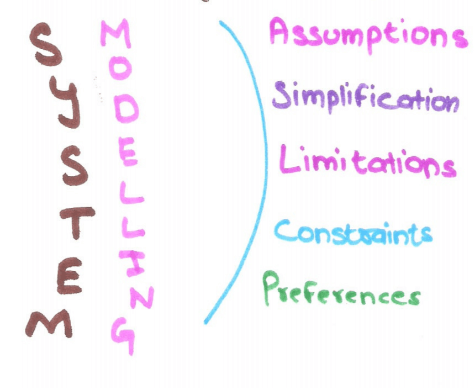
System Modelling
Definitions:
System Modelling is the process of developing abstract models of a system with model presenting a different view or perspective of that system.
or
A System Model represent aspects of a system and its environment.
or
System Modelling is a mean of representing a world view a detailed view of the system using same kind of Graphical Notation.
Features of a System Model :
• define the processes that serve the needs of the view under consideration.
• represent the behaviour of the processes and the assumptions on which the behaviour is based.
• explicitly define both a exogenous and endogenous input to the model.
• represent all linkages(input/output) that will enable engineer to better understand the view.
To construct a model, the engineers should consider a number of restraining factors- assumptions- simplifications - limitations - constraints - preferences

• Assumptions:
It enables a model to reflect the problem in a reasonable manner by reducing the number of possible permutations and variations.
Example: Representation of 3D human forms
In this input domain maybe that the system engineer makes certain assumptions about the range of allowable human movements.
(leg cannot be wrapped around torso) so that range of Input and processing can be Limited.
• Simplifications:
That enables the model to be created in a timely manner.
Example: A System Engineer is modelling the needs of the service organisational and is working to understand the flow of information that spawns a service order.
Although a service order can be derived from many origins, the engineer categorises only two sources.
Internal Demand and External Request
This enables a simplified partitioning of input that is required to generate the service order.
• Limitations: That help to bound the system.
Example: An aircraft avionics system is being modelled for future aircraft. Is the aircraft will be a two-engine design, the monitoring domain for propulsion will be modelled to accommodate a maximum of two engines and associative redundant system.
• Constraints: That will guide the manner in which the model is created and the approach taken when the model is implemented.
Example: Suppose a system for the 3D-rendering describes previously is a singleG4 based processor so computational complexity of problems must be constrained to fit within processing bounds imposed by the processor.
• Preferences: It indicates the preferred architecture for all data, functions and technology.
05- System Modelling- Software Engineering
CLICK HERE TO Download This PDF NOTES
